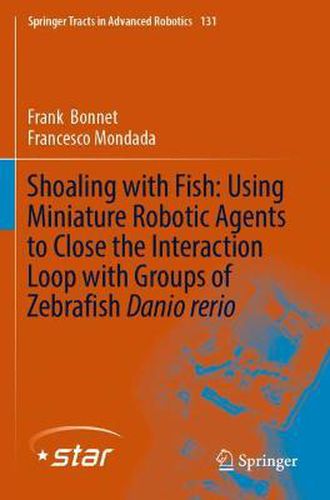Readings Newsletter
Become a Readings Member to make your shopping experience even easier.
Sign in or sign up for free!
You’re not far away from qualifying for FREE standard shipping within Australia
You’ve qualified for FREE standard shipping within Australia
The cart is loading…






This title is printed to order. This book may have been self-published. If so, we cannot guarantee the quality of the content. In the main most books will have gone through the editing process however some may not. We therefore suggest that you be aware of this before ordering this book. If in doubt check either the author or publisher’s details as we are unable to accept any returns unless they are faulty. Please contact us if you have any questions.
Robotic animals are nowadays developed for various types of research, such as bio-inspired robotics, biomimetics and animal behavior studies. More specifically, in the case of collective animal behavior research, the robotic device can interact with animals by generating and exploiting signals relevant for social behavior. Once perceived by the animal society as conspecific, these robots can become powerful tools to study the animal behaviors, as they can at the same time monitor the changes in behavior and influence the collective choices of the animal society.
In this book, we present novel robotized tools that can integrate shoals of fish in order to study their collective behaviors. We used the current state of the art on the zebrafish social behavior to define the specifications of the robots, and we performed stimuli analysis to improve their developments. Bio-inspired controllers were designed based on data extracted from experiments with zebrafish for the robots to mimic the zebrafish locomotion underwater.
Experiments involving mixed groups of fish and robots qualified the robotic system to be integrated among a zebrafish shoal and to be able to influence the collective decisions of the fish. These results are very promising for the field of animal-robot interaction studies, as we showed the effect of the robots in long-duration experiments and repetitively, with the same order of response from the animals.
$9.00 standard shipping within Australia
FREE standard shipping within Australia for orders over $100.00
Express & International shipping calculated at checkout
This title is printed to order. This book may have been self-published. If so, we cannot guarantee the quality of the content. In the main most books will have gone through the editing process however some may not. We therefore suggest that you be aware of this before ordering this book. If in doubt check either the author or publisher’s details as we are unable to accept any returns unless they are faulty. Please contact us if you have any questions.
Robotic animals are nowadays developed for various types of research, such as bio-inspired robotics, biomimetics and animal behavior studies. More specifically, in the case of collective animal behavior research, the robotic device can interact with animals by generating and exploiting signals relevant for social behavior. Once perceived by the animal society as conspecific, these robots can become powerful tools to study the animal behaviors, as they can at the same time monitor the changes in behavior and influence the collective choices of the animal society.
In this book, we present novel robotized tools that can integrate shoals of fish in order to study their collective behaviors. We used the current state of the art on the zebrafish social behavior to define the specifications of the robots, and we performed stimuli analysis to improve their developments. Bio-inspired controllers were designed based on data extracted from experiments with zebrafish for the robots to mimic the zebrafish locomotion underwater.
Experiments involving mixed groups of fish and robots qualified the robotic system to be integrated among a zebrafish shoal and to be able to influence the collective decisions of the fish. These results are very promising for the field of animal-robot interaction studies, as we showed the effect of the robots in long-duration experiments and repetitively, with the same order of response from the animals.